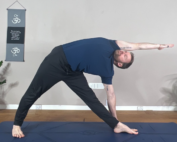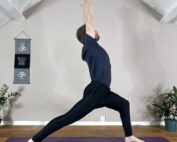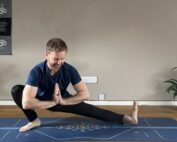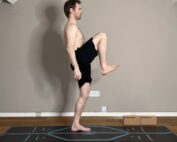
Enhance Your Yoga Practice with Pincha Mayurasana: Steps, Benefits, and Variations
Hi, I’m Dav Jones, a senior yoga teacher and teacher trainer. In this blog, we’ll explore the power and elegance of Pincha Mayurasana (Forearm Stand). Together, we’ll dive into its significance within the yoga asana practice, uncover its numerous benefits, and break down the key muscles engaged. We’ll also go step-by-step through the posture, review essential preparatory poses, and discuss modifications to suit all levels. Join me as we master Pincha Mayurasana safely and effectively, taking your yoga practice to the next level. Let’s begin!
What is Pincha Mayurasana?
Pincha Mayurasana, or Forearm Stand, is a dynamic inversion pose that requires strength, balance, and grace. Known as the Feathered Peacock Pose, it symbolizes elegance and inner power. This challenging asana engages the shoulders, core, and legs while cultivating a deep sense of poise and power.
Pincha Mayurasana Translation
- Sanskrit: Pincha Mayurasana
- Pronunciation: Pin-cha Ma-yu-ra-sa-na
- Meaning: “Pincha” means feather, and “Mayura” means peacock. Together, they describe the pose’s light and majestic quality.
- Yoga Level: Intermediate to Advanced
- Pose Type: Inversion
Benefits of Pincha Mayurasana
Physical Benefits
- Strengthens the Upper Body: Builds strength in the shoulders, core and legs.
- Improves Balance and Coordination: Challenges your stability while sharpening your focus.
- Increases Joint mobility and fascial flexibility: Opens the shoulders and chest, enhancing overall mobility.
Mental and Emotional Benefits
- Boosts Mental Clarity: The focus required enhances concentration and mindfulness.
- Reduces Stress: Inversions promote calmness and can help to alleviate anxiety.
- Builds Confidence: Overcoming the fear of falling empowers you on and off the mat.
Preparatory Poses for Pincha Mayurasana
Before attempting Pincha Mayurasana, it’s important to prepare your body with poses that help to mobilise the required joint along with lengthening and shortening certain muscle groups.
- Downward-Facing Dog (Adho Mukha Svanasana):

Purpose: Stretches the hamstrings and shoulders for increased flexibility.
How to Practice: Press down and back through your palms and lift your hips toward the ceiling, forming an inverted “V.”
2. Dolphin Pose (Ardha Pincha Mayurasana):

Purpose: Strengthens and mobilises the shoulders preparing the body for Pincha Mayurasana.
How to Practice: From Downward-Facing Dog, lower your forearms to the mat, keeping them parallel and shoulder-width apart.
3. Forearm Plank:

Purpose: Engages the core and encourages increased flexion in the spine. An ideal posture to support in the preparation for Pincha Mayurasana.
How to Practice: From a plank position, lower onto your forearms and hold the pose by pressing down through your elbows rounding the back and engaging the glutes.
4. Chest Openers:

Modified Puppy-Dog Stretch

Prone ‘Pec Minor’ Stretch
Purpose: Loosens the chest and shoulders for better alignment.
How to Practice: Spend 8/10 breaths in each of the above postures to receive an opening through the chest and shoulders.
Step-by-Step Guide to Performing Pincha Mayurasana

1. Find Your Alignment
- Place your forearms parallel and shoulder-width apart on the mat.
- Explore different forearm positions to see which provides the most stability and control in your body for Pincha Mayurasana.
2. Ground through your Foundation
- Flex your spine, contract through your core muscles.
- Curl your toes under and lift your hips into Dolphin Pose.
3. Kick Up into the Pose
- Shift your weight forward stacking shoulders over your elbows and forearms.
- Kick one leg up, then follow with the other, using the wall for support if needed.
4. Hold the Pose
- Fix your gaze on the floor for balance.
- Hug your forearms towards each other and push through your arms along with hugging your heels together.
5. Exit Mindfully
- Lower one leg at a time with awareness.
- Rest in Child’s Pose to regulate your nervous system.
Modifications and Variations for Pincha Mayurasana
Beginner Modifications
- Wall Support: Use the wall to explore a multitude of Pincha-inspired positions. There are many ways to utilise the wall when building the competence for Pincha Mayurasana. Not only does the wall provide a safety measure for the practitioner, it can also be a great tool to help build strength, technique and endurance.
Advanced Variations
- Scorpion Pose (Vrischikasana):

Explore other posture options on the forearms like Scorpion pose. This variation combines an inversion coupled with a backend.
- Pincha Mayurasana Hybrid Options – ‘Funky Pincha’:

Try combining a hand and forearm balance together by exploring different shapes and legs positions. All come with their own added level of nuance and technique and complexity.
Contraindications and Precautions
- Avoid the pose if you have neck, shoulder, or back injuries.
- Always warm up thoroughly before attempting inversions.
- Consult a physician if you have high blood pressure or other health concerns.
Breath and Focus in Pincha Mayurasana
Breath control is essential for maintaining balance. Inhale deeply to expand your chest and exhale slowly to stabilize your body. Let your breath guide your movement and keep you centered throughout the pose.
Final Thought
Want to master Pincha Mayurasana and build upper body strength? Join Dav Jones Yoga on Patreon for classes designed for all levels. With personalized guidance through the DJY mentorship program, you’ll refine your techniques and experience the transformative benefits of yoga. Whether you’re a beginner or an advanced practitioner, these resources will help you progress confidently. Elevate your practice and embrace your yoga journey with Dav Jones Yoga.









